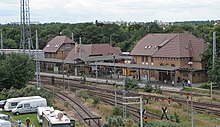Terminus

A terminus is a train station that, unlike the intermediate station , is the starting point or end point of one or more railway lines. Structurally, terminal stations can have been laid out differently. Frequently terminuses were as head station built where the main tracks blunt end at a buffer stop at the station. However, there are terminal stations that are designed as through stations, for example if a continuation of the route was planned or the route continued earlier. In the past, some terminal stations were built in the form of loops , so that the trains could easily change the direction of travel . However, because of the large curve radii required for this, this form has not caught on in the railroad.
Furthermore, the end point of a train journey or a train line can be referred to as the terminus.
Individual evidence
- ↑ Jörn Pachl , System Technology of Rail Traffic , Vieweg + Teubner 2008, ISBN 978-3-8351-0191-3 , glossary
- ^ Keyword: Bahnhof, in: Lexikon der Eisenbahn , Transpress; Stuttgart: Motorbuch Verlag, 1990, ISBN 3-344-00160-4 , pp. 69-71.
- ↑ a b train stations. In: Viktor von Röll (ed.): Encyclopedia of the Railway System . 2nd Edition. Volume 1: Cover - discontinuation of construction . Urban & Schwarzenberg, Berlin / Vienna 1912, p. 383 ff.